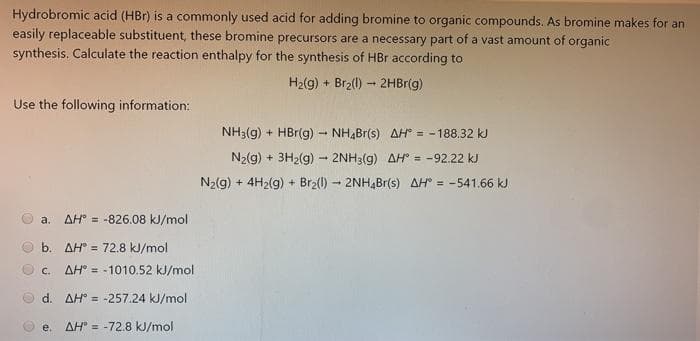Hydrobromic acid (HBr) is a commonly used acid for adding bromine to organic compounds. As bromine makes for an easily replaceable substituent, these bromine precursors are a necessary part of a vast amount of organic synthesis. Calculate the reaction enthalpy for the synthesis of HBr according to H2(g) + Br2(1) - 2HBr(g) Use the following information: NH3(g) + HBr(g) - NH,Br(s) AH = - 188.32 kJ N2(g) + 3H2(g) - 2NH3(g) AH = -92.22 kJ N2(g) + 4H2(g) + Br2(1) - 2NH,Br(s) AH = -541.66 kJ a. AH° = -826.08 kJ/mol b. AH = 72.8 kJ/mol c. AH° = -1010.52 kJ/mol d. AH = -257.24 kJ/mol е. AH° = -72.8 kJ/mol
Reactive Intermediates
In chemistry, reactive intermediates are termed as short-lived, highly reactive atoms with high energy. They rapidly transform into stable particles during a chemical reaction. In specific cases, by means of matrix isolation and at low-temperature reactive intermediates can be isolated.
Hydride Shift
A hydride shift is a rearrangement of a hydrogen atom in a carbocation that occurs to make the molecule more stable. In organic chemistry, rearrangement of the carbocation is very easily seen. This rearrangement can be because of the movement of a carbocation to attain stability in the compound. Such structural reorganization movement is called a shift within molecules. After the shifting of carbocation over the different carbon then they form structural isomers of the previous existing molecule.
Vinylic Carbocation
A carbocation where the positive charge is on the alkene carbon is known as the vinyl carbocation or vinyl cation. The empirical formula for vinyl cation is C2H3+. In the vinyl carbocation, the positive charge is on the carbon atom with the double bond therefore it is sp hybridized. It is known to be a part of various reactions, for example, electrophilic addition of alkynes and solvolysis as well. It plays the role of a reactive intermediate in these reactions.
Cycloheptatrienyl Cation
It is an aromatic carbocation having a general formula, [C7 H7]+. It is also known as the aromatic tropylium ion. Its name is derived from the molecule tropine, which is a seven membered carbon atom ring. Cycloheptatriene or tropylidene was first synthesized from tropine.
Stability of Vinyl Carbocation
Carbocations are positively charged carbon atoms. It is also known as a carbonium ion.

Trending now
This is a popular solution!
Step by step
Solved in 3 steps with 3 images









